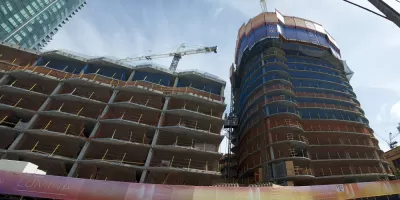The public and the "urbanism cognoscenti" do not see eye to eye when it comes to housing policy. A new survey makes the disconnect in opinions on matters of supply, regulations, and affordable housing very clear.

Liam Dillon shares the results of a survey conducted by USC Dornsife and the Los Angeles Times that reveals how complicated public opinion can get on matters of housing policy.
In fact, public opinion does not at all correspond to the consensus academic researchers, state analysts and California’s gubernatorial candidates, according to Dillon's explanation of the survey's findings:
A USC Dornsife/Los Angeles Times survey found that just 13% of eligible California voters believe that too little home building is a primary contributor to the state’s affordability issues. The answer ranked sixth among eight options offered in the poll, when first and second responses were combined. (Poll results reflect the percentage of people who chose a particular reason as their first or second option.) Lack of rent control topped the list with 28%.
Following lack of rent control was lack of funding for affordable housing. While political candidates, social media-savvy urbanists, and a growing YIMBY movement, among others, blame restrictive zoning for high housing costs, very little of the public agrees: only 9 percent of respondents pointed to finger at zoning regulations as the culprit in the state's housing crisis. The public also exhibited a strong preference for maintaining local control over allowing the state greater powers to preempt local regulations.
The article includes a lot more detail about the survey results and how they reflect on the big planning, land use, and housing policy actions and failures of recent years.
FULL STORY: Experts say California needs to build a lot more housing. But the public disagrees

Study: Maui’s Plan to Convert Vacation Rentals to Long-Term Housing Could Cause Nearly $1 Billion Economic Loss
The plan would reduce visitor accommodation by 25,% resulting in 1,900 jobs lost.

North Texas Transit Leaders Tout Benefits of TOD for Growing Region
At a summit focused on transit-oriented development, policymakers discussed how North Texas’ expanded light rail system can serve as a tool for economic growth.

Why Should We Subsidize Public Transportation?
Many public transit agencies face financial stress due to rising costs, declining fare revenue, and declining subsidies. Transit advocates must provide a strong business case for increasing public transit funding.

Alabama: Trump Terminates Settlements for Black Communities Harmed By Raw Sewage
Trump deemed the landmark civil rights agreement “illegal DEI and environmental justice policy.”

Dear Tesla Driver: “It’s not You, It’s Him.”
Amidst a booming bumper sticker industry, one writer offers solace to those asking, “Does this car make me look fascist?”

A Visual Celebration of Manhattan’s Chinatown Elder Community, Through Food
Lanterns, cafeteria trays, and community connection take center stage in this stunning photo essay.
Urban Design for Planners 1: Software Tools
This six-course series explores essential urban design concepts using open source software and equips planners with the tools they need to participate fully in the urban design process.
Planning for Universal Design
Learn the tools for implementing Universal Design in planning regulations.
City of Santa Clarita
Ascent Environmental
Institute for Housing and Urban Development Studies (IHS)
City of Grandview
Harvard GSD Executive Education
Toledo-Lucas County Plan Commissions
Salt Lake City
NYU Wagner Graduate School of Public Service





























